Ingredients for marinade
- 1xfresh onion
- 3xspring onions
- 10xfresh birdseye chillies
- 5xfresh garlic cloves
- 1oz fresh ginger
- 1xfresh tomato
- fresh coriander and parsley leaves
- 3xt.spoons of madras curry powder
- 3xt.spoons of tomato puree
- red food colouring
- salt & pepper
- olive oil
Ingredients for the curry mixture
- 1xkg diced shoulder of lamb or Chicken
- 4xlarge potatoes peeled and cut
- 2xfresh onions finely diced
- 6xfresh tomatoes chopped
- 3xgfresh garlic cloves chopped
- 1oz of fresh ginger chopped
- 5tsp madras curry powder
- Salt & Pepper
- 1xtsp coriander seeds
- 1xtsp cumin seeds
- 1xsmall stick of cinnamon
- 5xcardamon pods
- 1xbay leaf
- olive oil or ghee
- 3tsp tomato puree
- red food colouring
Marinade preparation
Chop all your ingredients into small pieces and put them in a bowl. Using a handheld blender or food processor blend the ingredients to a nice thick paste. Add your diced lamb to the mixture stir well and leave at room temperature to marinade or prepare the night before and leave the mixture in the fridge overnight.
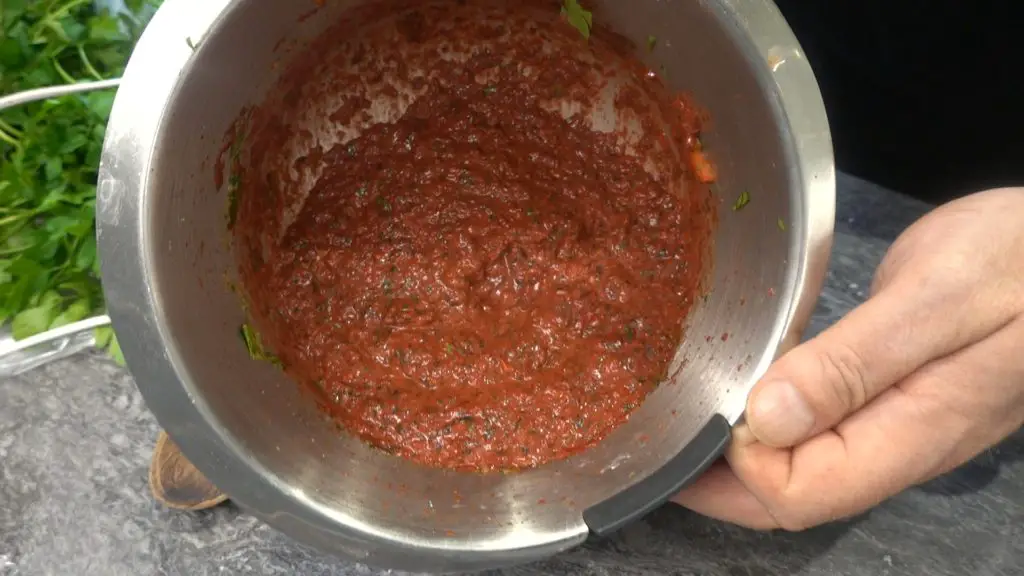
Start cooking
Place a thick-bottomed saucepan on the stove, add your ghee or olive oil and bring to the heat. add your dried spices to the oil but don’t let them burn. next pour in your chopped onions gives them a good stir and allow them to cook until translucent and just starting to change colour. Add your chopped tomato to the pot, give it a good stir mix the tomatoes and onions together then turn the heat down to medium and leave to cook and break down.
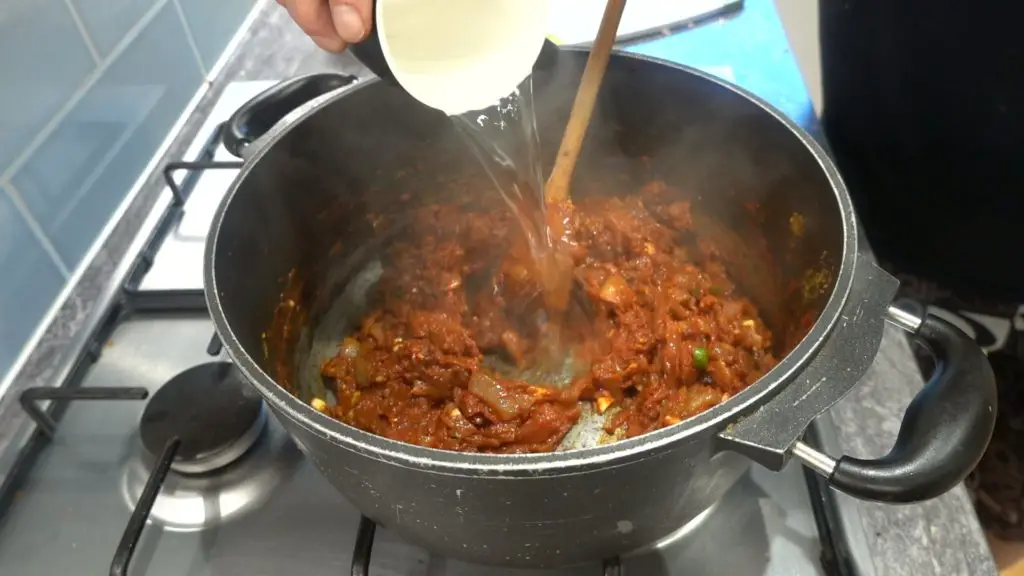
After about 30 minutes add the rest of the curry ingredients including the potatoes but not the lamb marinade or potatoes. Give the mixture a good stir and allow to carry on cooking on medium heat stirring regularly to prevent it from burning. If the mixture becomes a bit dry add some water to it and continue cooking for another 30 minutes. this is the most important part of the cooking process as it will give your curry that authentic tasting sauce.
Finish cooking
When the onions and tomatoes have fully broken down and you have a nice sauce add your chopped potatoes give them a good coating and allow them to cook for another 30 minutes on medium heat. add some water if the sauce is too dry and do not let it burn.
Remove the pot from the stove and pour the sauce mix onto a deep baking tray, pour the marinated lamb mix on top and put the tray with both mixtures into a preheated oven of 180c and allow to cook for 1 hour. after 1 hour remove the curry from the oven and give it a stir. return the curry to the oven and cook for a further 15 minutes.
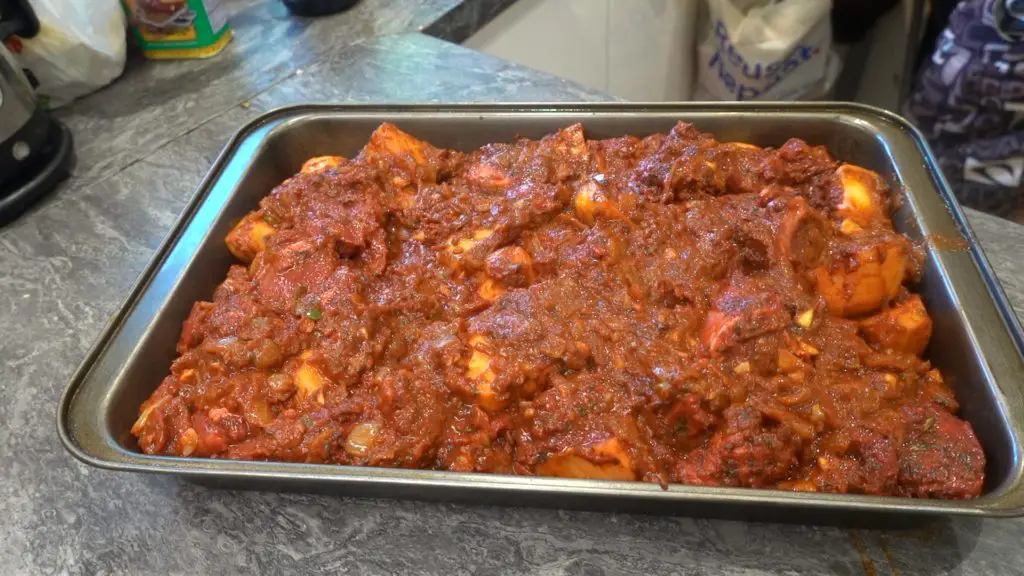
The main reason for cooking this curry in the oven is so you don’t have to keep stirring it in the pot on the stove as this breaks down the curry. this method gives you a lovely chunky finish instead of a plate of mushy slop.
Serve your lamb curry
Remove the tray from the oven and transfer the curry to a serving dish or plate up individual portions. Serve with rice and naan bread for the perfect finish. The rest is down to you. Bon Appetit.
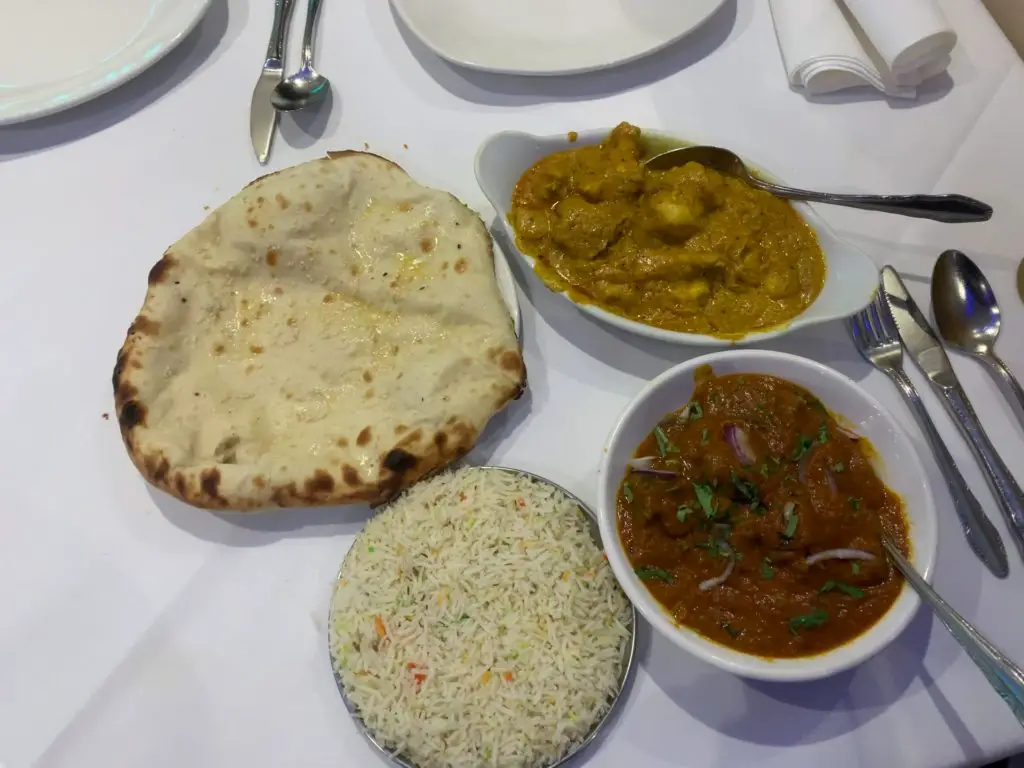
Which part of the lamb is best for Indian curry?
This is really down to preference and taste, I personally prefer to, and have always used the shoulder mainly because I love the flavour you get when the fat renders down. Yes I know it’s not good for you (apparently) and if you are health conscious or don’t like the fatty content then maybe try using the leg or rump, these may be more expensive choices but you will get a leaner curry.
Every part of the lamb can be used and in some cultures, the head, tail and other unmentionable parts are used and sometimes classed as a delicacy. The belly of the lamb is the fattiest part and normally the cheapest too. usually, this part of the animal is used for lamb sausages or slow cooker and braising recipes but in poorer countries, it is used as much as any other part of the lamb.
Lamb chops and lamb fillets would be the most sort after cuts of meat and also the most expensive. You can use these cuts for making curry but generally, they would be grilled or shallow fried. The fillets are great for spicey kebabs as they are succulent and tender.
The neck of the lamb is again very fatty and full of bone. Frowned upon by many, the old saying the old saying, the meat closest to the bone is the sweetest is very true in this case. Meat cooked on the bone is always more flavoursome and if you don’t mind getting your hands dirty and sucking the meat off the bone then this is not only t a cheaper cut of meat but also full of goodness. I would not recommend trying to cut the meat off this joint as it is fiddly and time-consuming. the best option for the neck is to braise or slow cook it until the meat breaks off the bone through the cooking process. This cut is often used in poorer countries where table manners and etiquette go out the window.
How do I thicken Lamb curry?
Depending on what recipe you are using, generally, you will more likely need to add liquid to a curry rather than thicken it. Unlike beef, Lamb is much tender meat and does not require as much cooking to become tender so making sure you have the correct amount of liquid, to begin with, will ensure you get a thick sauce consistency in the finished product. In the unlikely event that you find the dish is more like a soup than a sauce, finely chop some potatoes and add them to the pot whilst cooking, these will break down and give you a thicker consistency. You can use flour and water or a rue but this will give your curry gluttony and a very un-authentic taste.
How do you make the hottest spiciest curry?
When asked if the curry is spicey? they are generally asking how hot the curry is and this is a fraudulent slip as spicey and hot are two different meanings. In most authentic curry restaurants the dishes are traditionally hot as chillies are a part of the recipe. A hot curry is based on how many and what type of chillies you use in a recipe. Chicken korma for instance is spicey but very mild as hardly any chillies are used in the preparation of this very popular dish.
Different spices are used by different cultures and different countries(as I have experienced in my travels) for flavouring their food to their taste. An Indian curry has a completely different taste to Thai or Chinese curry and yet they all use spices. and although spicey food does tend to use chillies hot and spicey have two different meanings even though chillies are considered to be a spice.
Can you cook raw lamb curry in a slow cooker?
Yes, you can. Cooking is basically the application of heat, how you apply the heat can have an effect on the end product. A slow cooker is ideal for cooking stews and casseroles as these dishes generally use cuts of meat that take longer to cook and tenderise, slow cookers are designed to slow cook your food without having to keep watching and stirring, simply put the ingredients in, set the temperature & timmer and leave it to do the rest. Early forms of cooking were basic open fires with a makeshift rotisserie-style set-up, again this was great for bbq style cooking with the smoke from the burning wood giving it that smokey taste.
Cooking a lamb curry on an open fire or in a slow cooker can be done but you will not get the same effect as cooking it (as in the recipe above) in a hot oven. Cooking in an oven allows the curry to cook without steaming and because you are getting all-round heat it is evenly cooked without the necessity to keep stirring it and breaking the contents. A pizza oven is designed for the purpose of fast cooking so your pizza does not dry out and the bread cooks perfect, a tandoori oven is also designed to cook food fast and keep all the flavours locked in. so all this taken into consideration, yes you can cook raw lamb curry in a slow cooker but the end result will be better if you cook it in a hot oven.

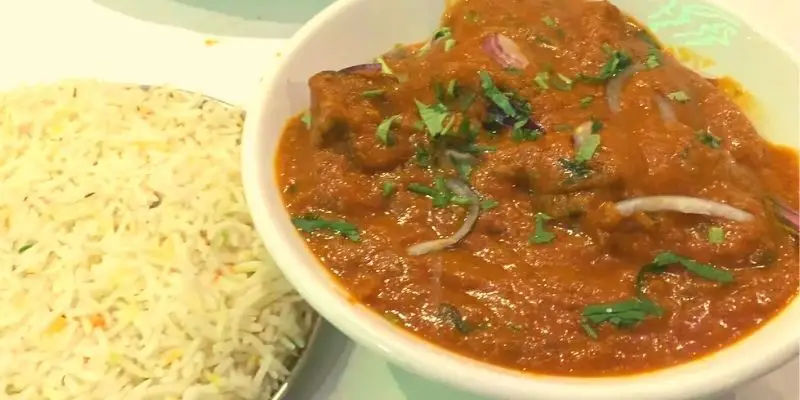



3 thoughts on “Simple Lamb curry secret recipe revealed quick & tasty”